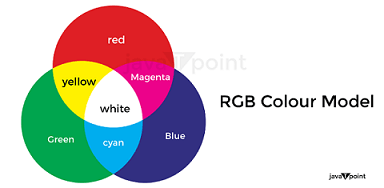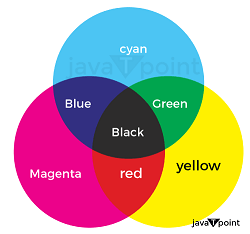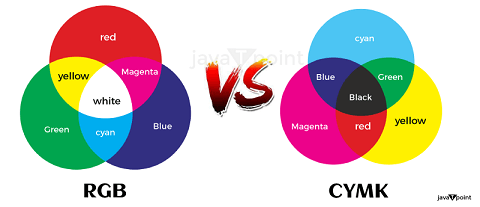Difference between RGB and CMYK
Both RGB and CMYK are colour models that are mainly utilized in graphic design to mix colours. These colour systems are produced differently depending on whether they are utilized for electronic or print media. RGB and CMYK are colour models offering an abstract numeric framework for specifying colours using three or four major numbers to represent the fundamental hues. The primary distinction between these colour systems is that the RGB model contains three colour channels. In contrast, the CMYK model contains four colour channels.
In this article, you will learn about the difference between RGB and CMYK colour models. But before discussing the differences, you must know about RGB and CMYK colour models with their uses, advantages, and disadvantages.
What is RGB Colour?
RGB is an abbreviation for "Red, Green, and Blue". It is the digital image colour scheme. It is also referred to as the "additive model". The model's name (RGB) is considered from the first letters of the three additive main colours, red, green, and blue. If the project is to be shown on any device, RGB mode is employed. The main purpose of this colour model is to identify, represent, and display images in electronic devices or gadgets, including LCDs, cameras, CRTs, scanners, and many others.

It is an additive mode that combines red, green, and blue colours in different degrees to generate a wide range of colours. When all three colours are added and exhibited to their fullest degree, the combination yields white colour, for example, RGB (255, 255, 255). When all three colours are blended to their smallest degree or value, the outcome is black, for example, RGB (0, 0, 0). The RGB colour system provides a large range of colours, so it is preferred in several computer software's.
Uses of RGB Colours
There are various uses of RGB colours. Some main uses of RGB colours are as follows:
- It is utilized in online branding.
- It is commonly utilized in application and web designing.
- It is also utilized in Social Media.
- It is utilized when the project contains digital screens, including LCD, LED, televisions, PC, smartphones, etc.
Advantages and Disadvantages of RGB
There are various advantages and disadvantages of the RGB colour model. Some main advantages and disadvantages of an RGB are as follows:
Advantages
- It is regarded as the primary colour space for many applications.
- It only applies to CRT applications.
- It doesn't require any transformation to display data on the screen.
- It is employed in visual displays because of its additive characteristic.
- The RGB model is mostly used in display monitors to generate varied colours.
- The RGB model is referred to as the additive model, as when these colours are combined with light, they generate a brighter result.
Disadvantages
- It is very complex to define a specific colour in RGB.
- RGB values are not often transferrable between several devices.
- Colour differentiation is not linear in RGB colours.
- Colour identification is not perfect in RGB colours.
What is CMYK?
CMYK is an abbreviation for "Cyan, Magenta, Yellow and K for Black". It is the colour model that is mainly employed in projects that include printed materials. It employs the primary colours cyan, magenta, yellow, and black, which are mixed to produce a variety of colours. The CMYK colour model is a subtractive colour model used in colour printing that also describes the printing process, commonly known as process colour or four colours.

The subtractive model is defined by the notion that the more colour is added, the more colour is eliminated from the white colour. A white colour is produced when all colours are combined to 0%. For example, CMYK(0%, 0%, 0%, 0%) for white that produces a black colour when all colours are mixed. Although, by adding equal quantities of every colour, grey colour shades may be produced.
Uses of CMYK Colours
There are various uses for CMYK colours. Some main uses of CMYK colours are as follows:
- It is utilized in advertising, such as billboards, posters, and flyers.
- It is utilized when a project requires physically printed designs.
- It is utilized in clothing branding, such as t-shirts.
- It is also utilized in tangible brandings, such as business cards.
Advantages and Disadvantages of CMYK
There are various advantages and disadvantages of a CMYK. Some main advantages and disadvantages of a CMYK are as follows:
Advantages
- It is less costly because of the unique printing technology of half toning.
- It needs less knowledge of colour theory than other forms of colour models.
- It is the industry standard for the majority of printing companies. Your printer can handle this type of artwork and file format. It is also utilized by most home printers.
- It is utilized in a wide range of media.
Disadvantages
- If you select a colour that is not within the printer's capabilities, the colour seems drab.
- The colours will not transition from RGB format cleanly.
- There are only a few colour options.
Key differences between RGB and CMYK

There are various key differences between RGB and CMYK. Some of the key differences between RGB and CMYK are as follows:
- The RGB colour model is referred to as the additive model, as when these hues are combined with light, they generate a brighter result. In contrast, CMYK is a subtractive model in which you start with a white sheet of paper and add additional ink to produce a dark outcome.
- When compared to the CMYK model, the RGB colour model allows for faster task execution and requires less memory space.
- The light is utilized in the RGB colour model to change the intensity of the resulting colour. In contrast, the CMYK colour paradigm utilizes ink to change the colour intensity.
- The RGB colour model is mostly utilized in display monitors to generate varied colours. On the other hand, the CMYK colour model is widely utilized in printing materials.
- Images using RGB colours are more vibrant. In contrast, CMYK colours are less vibrant.
- The RGB and CMYK colour systems have a straightforward relationship. In an RGB colour model, the yellow colour is generated by mixing red and green colour. In contrast, with the CMYK colour system, the yellow hue is produced by subtracting the blue colour from the white colour.
- RGB produces white light when 100% of each colour is added together. No light is generated when 0% of each colour is added, resulting in black. In the CMYK colour model, adding 100% of each colour generates black, while adding 0% of each colour produces white.
- RGB colour model is mainly utilized for digital graphics, online logos, images for sites, apps, online advertisements, etc. In contrast, the CMYK model is mainly utilized for business cards, posters, stickers, stationary, etc.
Head-to-head comparison between RGB and CMYK Colour Model
Here, you will learn the head-to-head comparisons between RGB and CMYK colour models. The main differences between RGB and CMYK colour models are as follows:
| Features |
RGB |
CMYK |
| Full Forms |
RGB is an abbreviation for Red, Green, and Blue. |
CMYK is an abbreviation for Cyan, Magenta, Yellow and K for Black. |
| Definition |
It is also known as the additive colour model because when these colours are added with light, they produce a brighter outcome. |
It is also known subtractive colour model, in which we start with a white sheet of paper and add additional ink to produce a dark outcome. |
| Colour Intensity |
Light is commonly utilized in this model to modify the intensity of the resulting colour. |
In this colour model, the ink is commonly utilized to modify the colour intensity. |
| File Size |
The RGB colour model allows for faster task execution and requires less memory space. |
The CMYK colour model utilizes less memory space. |
| Application |
The RGB colour model is mostly utilized in display monitors to produce varied colours. |
CMYK colour model is primarily utilized in printing. |
| Generation of Yellow Colour |
The yellow colour is created by combining red and green light. |
The yellow colour is produced by subtracting blue light from white light. |
| Effect |
The white colour is created by adding the RGB colours. |
The addition of CMYK colours yields black. |
| Nature |
It produces white light when 100% of each colour is added together. No light is generated when 0% of each colour is added, resulting in black. |
In the CMYK colour paradigm, adding 100% of each colour generates black, while adding 0% of each colour produces white. |
Conclusion
The two-colour models RGB and CMYK function better for their intended utilization. For example, RGB is better for presenting colours on display systems that employ red, green, and blue light. On the other hand, CMYK is suitable for printing ink because it works completely opposite to monitors. Although, the RGB colour spectrum is larger than the CMYK.
|



 For Videos Join Our Youtube Channel: Join Now
For Videos Join Our Youtube Channel: Join Now










